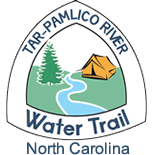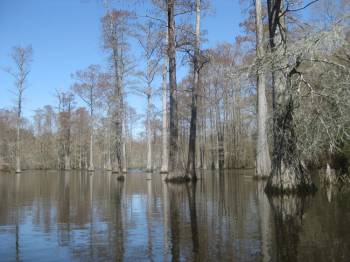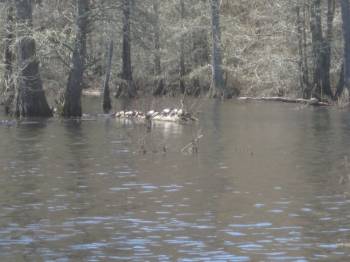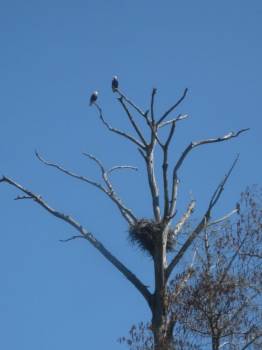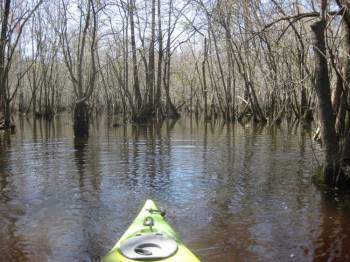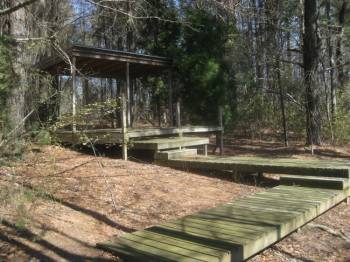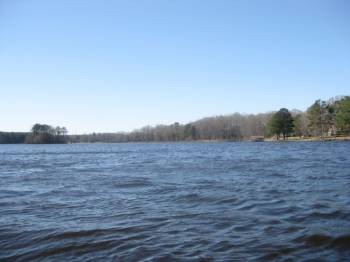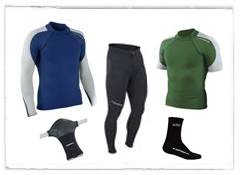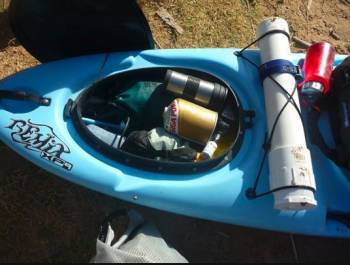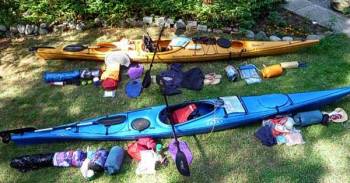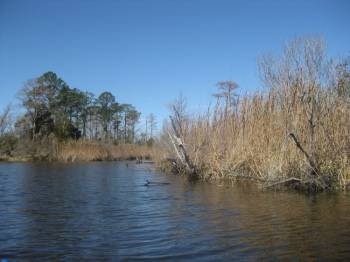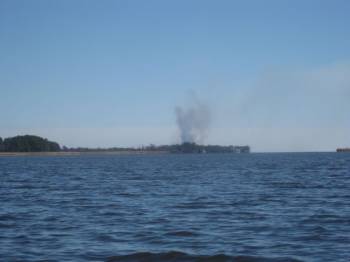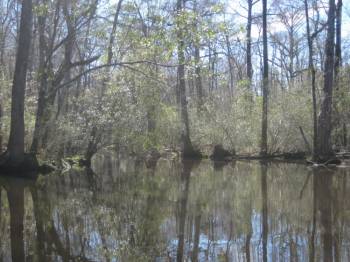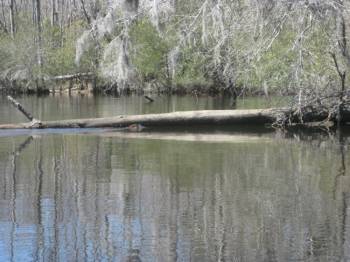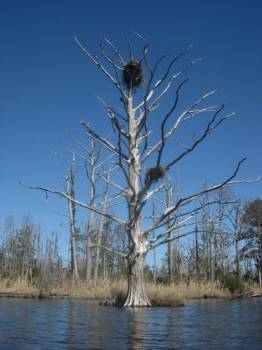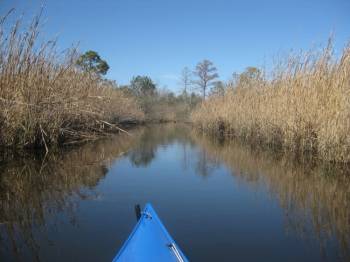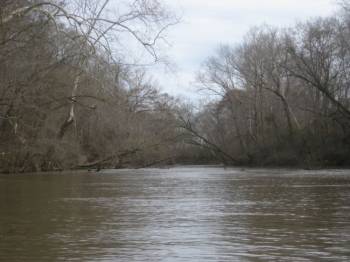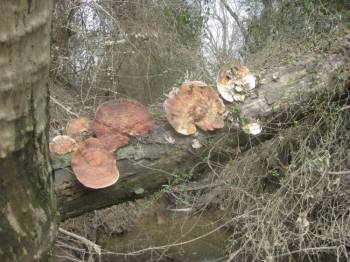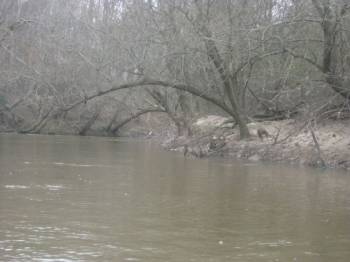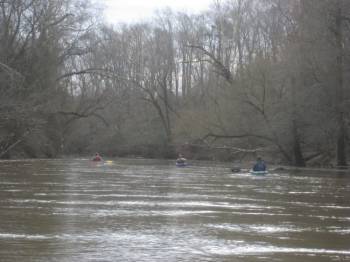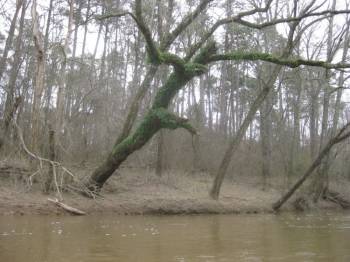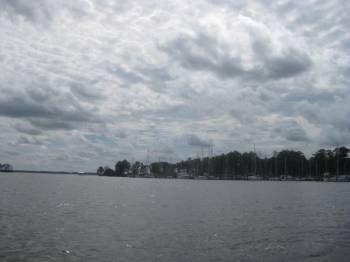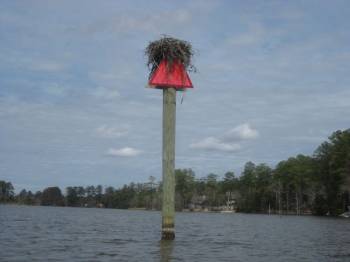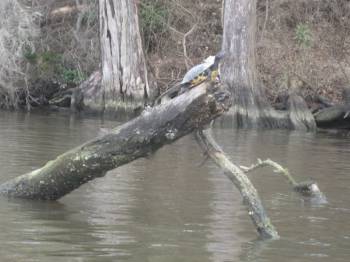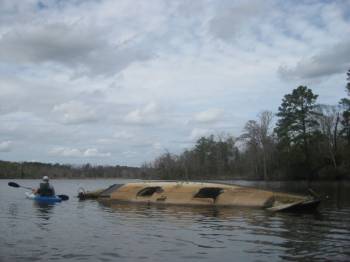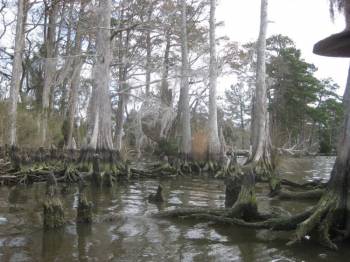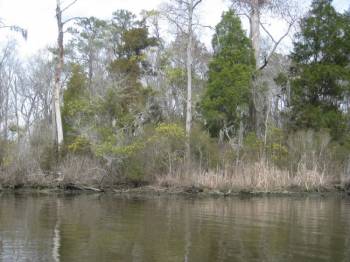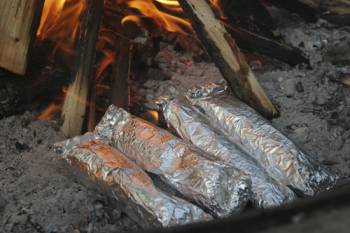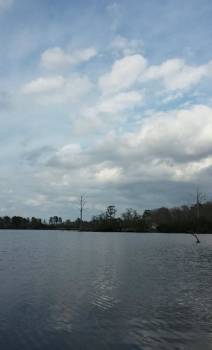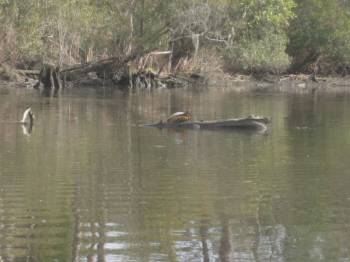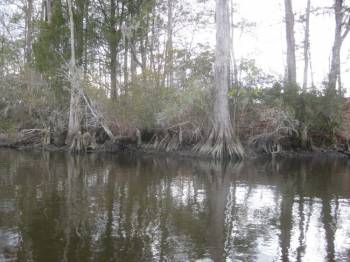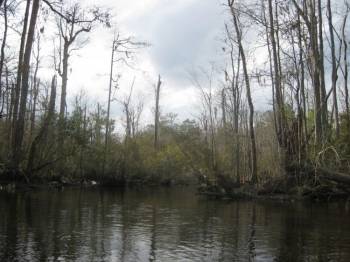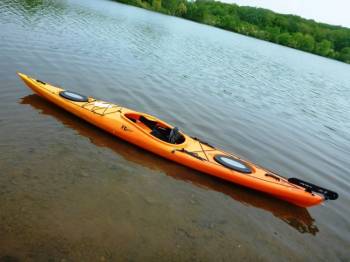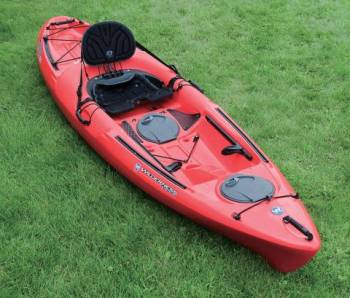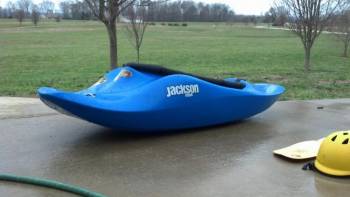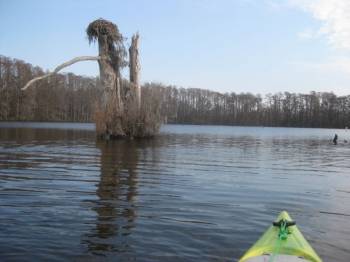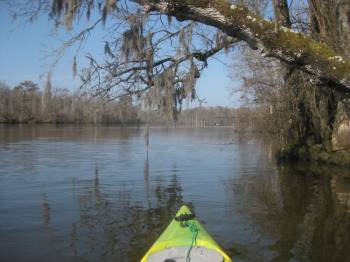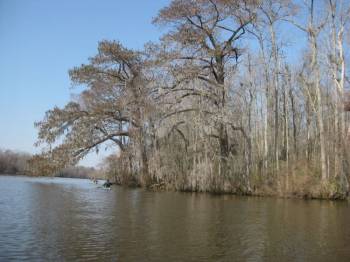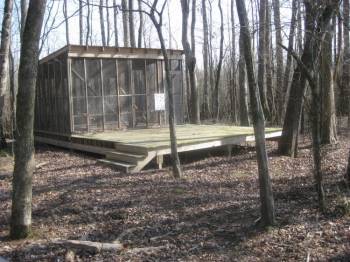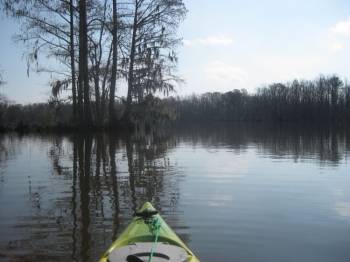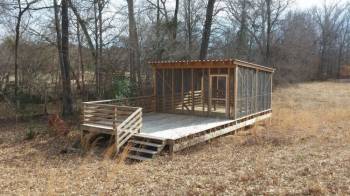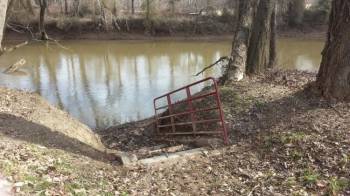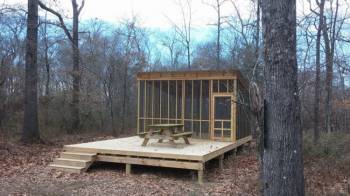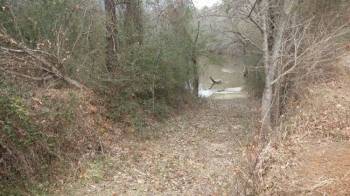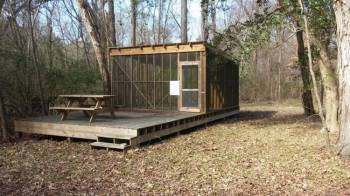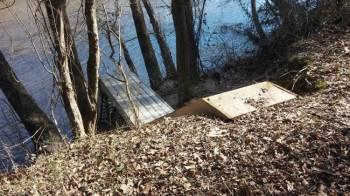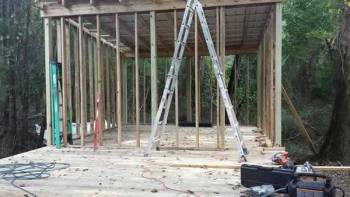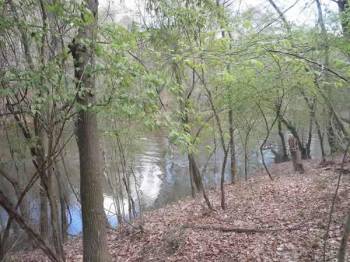CAMPING PLATFORM RESERVATIONS ARE NOW OPEN!
***Please call (252) 946-7211 or email admin@soundrivers.org to make your reservation. We are currently having issues with our PayPal payment system***
I recently went on my last paddle as an intern here with the Pamlico-Tar River Foundation. I couldn’t have asked for a more beautiful day to do it. The sky was clear and the temperatures were at a very comfortable 72 degrees. Long time PTRF member Bob Hudkins took me out to two different locations near Rocky Mount. We met in Rocky Mount at 12 o’clock and I followed him out to our first destination, Sapony Creek. We pulled over just after the bridge crossing the creek on Sandy Cross Road. After untying the kayaks from our cars and getting everything in order, we walked them down the embankment and slid into the water.
The first impression I had upon paddling into the creek was that I was floating through the woods. Trees grew straight out of the water everywhere I looked. As we paddled up the creek we wound our way through the trees, often having to paddle around groups of trees that grew too thick together. 15 minutes into the paddle we caught sight of a log in front of us that was covered in turtles. We crept closer for a better look. Thankfully only a few of them retreated into the water, allowing us to take a few photos before we moved on. We paddled along as the swamp slowly curved to the right, and Bob suddenly stopped and pointed out a tall tree a couple hundred feet in front of us. A large eagle’s nest was built in between a fork in the branches near the top of the tree, and a bald eagle was perched on a branch above it. We both got our cameras out and snapped a few photos, paddling a little bit closer in between each picture. After admiring the eagle for another minute we continued through the swamp, which got continually thicker the further in we paddled. At one point appeared that we would have to turn around, but we found a narrow pathway on the left that made a loop back around to the eagles nest. Upon arriving back at the eagles nest, we looked up and saw that there were now two eagles perched in the tree. One of them took off and flew high above us. I’d always heard about how majestic the bald eagle looks while in flight, and watching it soar through the air truly was a sight to see. After taking another few photos of the eagles, we paddled back to the put in and tied our kayaks back onto our cars.
We drove about 10 minutes to the main part of the Rocky Mount Reservoir and stopped at a public boat access off of Old Carriage Road. After getting back into our boats, we paddled upriver and around a bend to the left towards Goat Island, a small island in the middle of the reservoir. Rocky Mount has two camping platforms with a similar design to PTRF’s platforms, and one of them is located on this island. The shoreline on the approach to the island was dotted with houses on large open fields of grass running down to the water. The wind had picked up considerably, and it blew against us as we moved toward the island, slowing our progress. We reached the island and found the dock for the camping platform. We docked our boats and got out to inspect the platform. The sounds of geese calling to each other permeated the whole island. It seemed they had adopted the island as their home. Indeed, upon reentering the water and circling the island, we saw several females laying on their nests, and crowds of geese walking around on its shores. We circled the island in about five minutes and then headed back towards the put in. With the wind at our backs we made much better progress and found ourselves on dry land again around 4 o’clock. As I fastened my kayak to my car, I my thoughts went back to all of the places I have seen while interning with PTRF. I felt and still feel incredibly blessed to have had the opportunity to explore the waterways along the Pamlico-Tar River watershed, and look forward to sharing the beauty of these waterways with my family and friends in the years to come.
Have you ever planned a multi-day kayaking trip? The idea of going kayaking for the day always excites me. Getting to spend a few quality hours on the water away from everything is as invigorating as it is therapeutic. So going kayaking for several days on end? Let’s just say I feel like a new person coming back from those paddles. The only trouble is that sometimes planning these multi-day trips can be a hassle. What to pack is often one of the things new overnight paddlers have trouble with. With this in mind, I have compiled a brief list of items to get you thinking about what you should bring on your trip. This list is not exhaustive, but the below are items that no kayaker should be without when going on a multi-day adventure.
Drytop
Drypant
Pants (at least 1 pair synthetic or quick drying)
Shirts (at least 1 synthetic or quick drying)
Sandals or water shoes (while in the kayak)
Tennis shoes or boots (for camp)
Spray jacket and/or rain gear
Swimsuit
Paddling or synthetic gloves
Socks
Underwear and long underwear
-Camp gear
Tent w/rain fly and footprint, or hammock
Sleeping bag
Sleeping pad
Camp stove w/fuel
Meals
Pot/pans
Utensils
Matches or lighter
Small camp chair (such as crazy creek)
-Other
First aid kit
Dry bags
GPS
Compass
Flashlight/headlamp
Spare paddle and PFD
Signaling devices (whistle, mirror)
Sunglasses
Sunscreen
Bug spray
Hat
Throw rope
Knife
Snacks
Emergency water treatment
If you live in Eastern North Carolina and are looking for a great short paddle, then Chocowinity Bay should be among the top choices on your list. It offers wide open views of the bay, and further up, it gives access to winding creeks through the swamps with an up close look at the plants and animals that inhabit the area. I had the pleasure of paddling several miles of this waterway with two longtime members of PTRF, Guy Blackwell and Buster Thompson. We met at a neighborhood put in just after 12 that was located right next to the bay and were in the water within a few minutes.
At the start of the paddle we navigated our way through narrow waterways lined with reeds on either side. It was just a little chilly but was warming up, the sun shining with almost no clouds in the sky. After a few minutes of paddling we emerged into the bay itself, the water stretching out in front of us until it met the blue sky on the horizon. After our initial observation of the bay we noticed a plume of smoke on the bank far ahead of us, the source of it hidden from view. We surmised that it must have been Goose Creek State Park staff burning the some of the underbrush in its woods. This was later confirmed upon talking to Goose Creek staff. After paddling into the bay a little ways we turned and directed our kayaks towards a creek that skirted the shoreline, the left shore of which was overgrown with reeds.
This creek soon became narrower and swampier, both banks having an abundance of cypress trees and various other plant life. A rustling to my right caught my attention and a large vulture took off only about 10 yards away. I guessed it was feasting on something, but couldn’t see whatever it was. At this point Guy and I were in the lead and we both saw the same thing at the same time. A beaver was swimming across the creek in front of us, its head just above the surface of the water. We stopped paddling to watch it until it reached the opposite bank and dove under the water, presumably having reached its home. Only minutes later we approached a large turtle warming itself in the sun on a log. As we were passing, it slid off the log and back into the water. It wasn’t long before we again saw movement in the water. It was another beaver, swimming along in the water in the same fashion the previous one had, and disappearing under the water in the same way. The second beaver’s disappearance was followed by a loud splashing to my right. I turned to look, expecting yet another beaver, but all I saw was the ripples left by something large that had just submerged. We paddled on without any incident for some time, and just after we passed under highway 33, we were forced to stop. A tree had fallen across the creek and blocked our passage, so we had no choice but to turn and retrace our steps.
On the way back, we turned to take an alternate path on a fork in the creek that we had passed earlier. This soon took us out of the trees and into a more wide open channel, the thick reeds again taking over the shore to our right. As we slowly paddled by, we could hear the sound of the reeds being blown by the wind, brushing against one another. An old sailboat came into view, laying at anchor in a small cove. It looked as though it hadn’t been used in years. We soon emerged again into the bay, the smoke from the fires at Goose Creek State Park still rising from the trees in the distance. We paddled across the bay to the other side, stopping in front of a large tree with two osprey nests in it. It was only about a 10 minute paddle to the put in from the tree, so we turned and followed the shoreline. Before long, two small channels appeared on our right, about 10 feet across. After paddling single file through this channel, the put in came into view. This was one of the most enjoyable paddles I have been on in some time. There was never a shortage of things to see, and had we wanted too, we could have continued our exploration of the bay area for the rest of the afternoon. Upon putting the boats on the trailer, I had already resolved to come back in the future and paddle the same trail again.
A few weeks ago I contacted Kim, a blogger and Recreation Manager for Durham Parks and Rec. I invited her to come paddle part of the Tar-Pamlico River Water Trail with myself and our Riverkeeper, Heather. The idea was to show them a part of the trail and one of our camping platforms, in an effort to get them excited about the trail and get them thinking of the possibilities it has for recreation in and around Durham. Kim also agreed to write a post about the trip on her blog, Get Outdoors Durham!, which you can check out here: http://getoutdoorsdurham.blogspot.com/. We set up the trip for Friday, and after a brief scare from the weather – which turned out to be a false alarm – we met Kim and her coworker Ryan at the put in on the Tar River, just downriver of Rocky Mount. After introductions and unloading the kayaks, we began our 10 mile paddle down the river.
It was a chilly morning, but we had all dressed appropriately, and the brisk morning air refreshed our bodies after a long week of work. The river was a little bit high due to recent rains, and the current was moving just enough so we could paddle at a leisurely pace and still make good time. We made our way two by two down the river for some time, making conversation and enjoying the paddle. Woods lined the banks on either side of the river, and many of the trees on the banks leaned out, their trunks angled over the water – and sometimes almost horizontal to it. A small group of wood ducks suddenly appeared a little ways ahead of us, flapping their wings and taking flight to distance themselves from us. The sound of their calls died down as they went around a bend in the river ahead. A pileated woodpecker flew by, and we later heard it pecking at a tree somewhere out of sight. A downed tree to our right caught everyone’s attention. Growing on the trunk were large fungi, bigger than my head. We stopped for a moment to admire them and take a few photos.
As we passed under a bridge Heather caught sight of a barred owl. It was perched on a branch nearby, watching us as we paddled by. Soon after that a kingfisher flew past us on its way upstream, perhaps on its way to its favorite hunting spot. Many other birds flew by as we continued on our way downriver. There were other kingfishers, a great blue heron, mallards, a red tail hawk, and other hawks that we couldn’t identify. We continued to run into the wood ducks from earlier in the paddle. They kept flying a little ways downriver and landing, and we kept catching up to them, prompting them to take flight again. As we neared the Bourne camping platform, where we planned to have lunch, I was bringing up the rear of the party, having just taken a picture. I heard a rustling in the underbrush on the bank to my right, and turned to look. The rustling continued and it caught everyone else’s attention as well. We were straining our eyes to see what it was, when suddenly a large beaver walked out of the brush and dove into the water. I remember it’s wide, flat tail being the last thing I saw before it disappeared. With this sight still fresh on our minds, the camping platform came into view in front of us, partly hidden by the trees on the bank. We got out at the take out ramp and walked to the platform to have lunch and a short break.
We soon resumed our positions in our kayaks and continued on our way. The longest stretch of the paddle was over, and there were only a few more miles to go before we reached Dunbar Bridge, our take out. There were still sights to be seen however. We passed by large mistletoe clusters hanging high in the trees, as well as a few bird nests resting on branches overhanging the water. A second barred owl flew above our heads and trees with strange root patterns and oddly shaped trunks slowly passed us as we floated by. Just before the take out, we passed under a tree leaning over the water, completely covered in greenery that was in stark contrast with the rest of the unadorned trees around it. A short time after, we paddled under Dunbar Bridge and landed on the ramp. The kayaks were soon loaded onto the truck and we were on our way shortly thereafter. I’ve never had a disappointing paddle on the Tar River yet, and this day was no exception. I had never seen such a variety of wildlife on any paddle, which has me wondering what other surprises lay in wait for me on my next trip.
As I am working on promoting the Tar-Pamlico River Water Trail, it is always a good idea to familiarize myself with the current, as well as the future trail. With this in mind, Matt Butler and I decided to go for a brief paddle on Broad Creek, where we plan to start building a new camping platform in the next couple of months. Broad Creek is one of the Pamlico River’s tributaries, and is located east of Washington, before you reach Goose Creek State Park. It was a beautiful day with white clouds and a blue sky to compliment them. We started our paddle from a small launch at the Washington Yacht and Country Club. The water was just barely choppy, pushing us forward as we paddled past the docks with countless boats at rest. As we left the docks behind, we approached a water sign that was adorned with an osprey nest. As we passed the nest, we saw an osprey flying towards us along the tree line. It landed on a tree not far from us, as if it were waiting for us to leave its nesting area.
We continued on, passing countless cypress trees, many of them sporting the Spanish moss so common along the water trail. One of the trees growing among a large group of cypress knees had a bird house mounted on it, with a metal plate stretched out below it to stop snakes and other predators from reaching the birds inside. Just downstream we happened across a turtle bathing in the sunlight on top of a log. I managed to snap a photo before he dove into the water. A strange sight reached us as we paddled around a bend in the creek. An old boat was lying on its side, half submerged in the water. We paddled in for a closer look, investigating its weathered and rusted deck. As I passed close by I heard a splashing from within. It seems that something had made quite a comfortable home from the wreck.
Within the next few minutes we reached a fork in the creek, and paddled off to the right, where the location for the new camping platform is located. Further down this fork in the creek I could see a small bank with a fisherman relaxing in the afternoon sun. Before we reached him however, we arrived at the future platform location, shown in the photo below and to the right. We continued down the creek for another half hour, passing under Broad Creek Road. The creek started becoming narrower and shortly after passing a small house on the banks, we turned and headed back towards the put in.
The paddle back was much faster, the first half of which afforded no new sights. However, as we again passed by the sunken boat and turned the corner, we noticed a towering tree, naked of any leaves, with a large osprey nest resting high in its uppermost branches. Two seagulls caught our attention as we neared the wide open stretch of water in front of the country club. They were fighting over a dead fish that floated between them. After a few moments of them wrestling on the water, one of them flew away, leaving the victor floating next to its meal. After passing the site of this altercation, I looked in the distance and saw a sailboat slowly floating in to anchor at the country club. We soon followed suit, our kayaks scraping to a stop on the ramp as we reached the end of our paddle. Like all of the paddles I have done so far, Broad Creek has a lot to offer. Whether you are looking for a peaceful paddle, to see the creek’s wildlife, or – in the near future – a place to camp on the water, Broad Creek won’t disappoint you.
If finding recipes for overnight paddles isn’t your favorite thing to do, then you’re not alone! The process of figuring out a meal that’s not only easy to prepare but also tasty can sometimes be a daunting one! With this in mind, I have compiled a short list of a few simple meal ideas that are easy to pack in a canoe or kayak and taste great. I will be focusing on dinners in this post.
The first recipe is one of my favorites: camp pizza! In addition to the ingredients below, all you need is a camp stove or fire, a frying pan, bowl, spoon, and knife.
Ingredients:
Bisquick
Tomato sauce
Mozzarella cheese (any cheese will work)
Toppings of choice (pepperoni, sausage, oregano, red pepper, etc.)
Olive oil
Water
First pour a little olive oil on the frying pan to ensure the dough doesn’t stick. Then mix water in a bowl with the desired amount of bisquick until it has a slightly doughy consistency. Get your frying pan warm on your heating source and then spread the dough evenly across the pan with the spoon. Spread the sauce on top and then add your toppings. Lastly, sprinkle the cheese on top of everything and cover the pan with a lid. Cook until the cheese melts and the dough is cooked through. Don’t have the heat too high or you may burn the dough! After it is done simply cut it up with the knife and enjoy!
The next recipe is burritos. This is very simple and has almost no prep time involved, save for the packaging of all the ingredients. Additional things you may need for this is a knife and plate to cut up the tomatoes, tin foil, and gloves.
Ingredients:
Tortillas
Cheddar or Mexican blend cheese
Refried beans
Spinach or shredded lettuce
Tomatoes
Salsa
Sour Cream
It may make the prep easier if you cut up all the tomatoes at home and put everything in individual plastic bags in your cooler. All that’s necessary to prepare these bad boys is to combine all the ingredients and wrap them up in the tortilla, and then if you want a hot burrito, wrap them in the tin foil. You can then place the burrito near the fire or in the embers of the fire for a short time until they are heated up. Use your gloves to remove them from the embers and you’re ready to eat!
Last but not least we have the hobo dinner! This is a classic favorite of campers and has almost endless possibilities. You will need gloves and tin foil for this recipe, as we will be using it in the same way we did the burritos above. The idea is to combine a bunch of ingredients together and cook it in tin foil over the fire. You can use any number of ingredients, but I chose the classic hobo hamburger.
Ingredients:
Hamburg patties
Potatoes
Onions
Carrots
Salt and pepper to taste
Worcestershire sauce to taste
Butter or margarine
Other options include corn, peas, peppers, cheese, and seasonings of choice
It is advised to do all the cutting for the ingredients beforehand so it is easier to prepare it while at camp. To prepare this delicious meal simply lay out all the ingredients on the tin foil and wrap it up. Then place it in the coals of the fire and wait until the beef is cooked through. Remove the wrap from the coals with your gloves and dig in! The possibilities are almost endless when it comes to camp meals. I hope these recipes have inspired you to try new things and hope you get the chance to try them next time you're at camp!
With weather that had been cold and overcast for the past week, I was excited on Tuesday to see Wednesday’s forecast looking so good. I lost no time in putting a paddle trip together. With the hundreds of miles of paddling opportunities in Eastern North Carolina, I had a lot of options to choose from. I decided on Blounts Creek, a 14 mile long waterway in Beaufort county. I recruited Morgan, one of my college friends also interning in Washington, to come with me. We left Washington at 1 o’clock Wednesday and reached Cotton Patch Landing, our put in, shortly thereafter.
The sky was blue and the sun was shining on the rippling face of the water as we slid in our kayaks and began paddling away from the landing. The first stretch of the creek is fairly wide, with marshy peninsulas and a large stretch of open water. Several fishing boats were anchored in this area with fishermen lounging on the decks, rod in hand. We soon rounded the first bend in the creek, leaving the fishermen behind as the water became shallower. The banks of the creek were lined with a vast array of vegetation – cypress trees lined the banks, their roots stretching out and submerging in the water. Innumerable shrubs and small trees wove themselves together, creating a wall of foliage on either side of us. We approached a partly submerged log in the water in front of us, and saw several turtles warming themselves in the sun on the elevated portion of the log. The colored striped on their outstretched neck caught our eyes, some yellow, and some orange. All but the largest retreated into the water as we approached. We slowly floated by, only feet from the turtle, trying not to move and expecting it to drop into the water at any moment. It stared us down as we passed, but maintained its ownership of the log.
After rounding another bend in the creek, my eyes were drawn upward to a tree overhanging the water. The sun’s rays reflected off its yellow leaves and gave them a shimmering gold appearance. As we passed under this tree I began to notice young bamboo stalks growing along the sides of the river, the deeper green of their leaves contrasting with the rest of the undergrowth. We suddenly realized that the creek had become much narrower at this point. It had been getting smaller so slowly that we had barely noticed it. We were paddling one in front of the other now, there not being enough space to paddle side by side. Two downed trees that had fallen in the water were slowly getting nearer ahead of us. For a moment it looked like this would be as far as we would go, but I noticed a small almost concealed pathway right next to the bank that was unobstructed, save for a few branches under the water. We managed to get by the trees following this path and resumed our trek up the creek. It was only a few more minutes before our path was again blocked by a downed tree. This time, there was no pathway around, so we turned and started paddling downstream.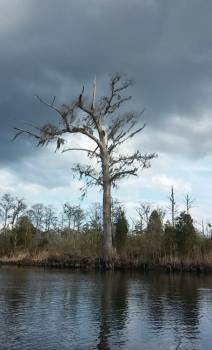
As we paddled back down the creek, everything was so serene it instilled a sense of peace in me. The world seemed to be resting, the silence broken only by the sounds of the insects chirping, a distant bird calling, or the wind rustling through the trees along the banks of the creek. The wind blew across the water in front of me, making ripples along the surface and letting me almost see the breeze as it passed. Since we were moving downstream now, we stopped paddling for a while and drifted with the current. A large tree towered above the rest of the tree line on the shore in front of us. Spanish moss hung from its otherwise bare branches, gently waving in the wind as we paddled by it. As we neared the wide open part of the creek where we started, my attention was drawn to the cypress knees in the shallow water near the bank. The particular group that caught my attention had one that almost looked as if it had been carved. I paddled nearer and thought I could distinguish a perched eagle carved at the top. I concluded after a few more moments that it hadn’t been carved, but I still marveled at how closely it resembled an eagle. Nature is full of natural art, and this was certainly no exception.
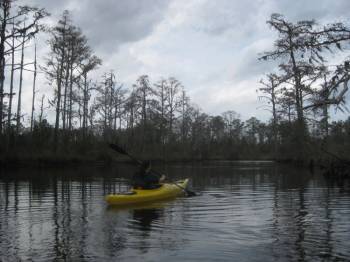
If you are considering buying a kayak, there are many things that should be taken into consideration before you make a purchase. First and foremost, what kind of kayaking do you want to get into? There are three main types of kayaking: touring, recreational, and whitewater. Once you decide that, there are many other things to think about.
The type of kayak you get will decide in many ways what your paddling experience will be like. Different boats are better suited for different kinds of paddling. Touring kayaks are designed for long paddles in open water, and are typically used for coastal and sea kayaking. They are great for overnight trips as well, with spacious hatches that will carry plenty of gear. These are usually between 12-17 feet long and often come with a rudder that can be operated with the feet inside the cockpit. These kayaks often tend to be on the more expensive side. Recreational kayaks on the other hand are affordable and easy to use. They are designed for paddles on calmer waters and for shorter distances. They are frequently used on lakes and calm rivers. They tend to be between 10-12 feet and are popular for beginner paddlers, as well as fishermen due to their customizability and stability in the water. Whitewater kayaks are very specialized and come in many different designs such as creek boats and play boats. They are typically 4-10 feet long and are shapped with whitewater in mind - the bow and stern typically curved upwards and a orunded hull.
The size of your kayak is very important. No matter what kind of kayaking you are doing, they come in many different sizes. A longer kayak will glide through the water faster and with less effort but it will be harder to turn. A shorter and wider kayak such as whitewater kayaks will be more stable and much easier to turn, and will perform better in rougher water than longer models. Wider kayaks are much more stable but require more paddle effort to move forward. When considering the length of your kayak, take note of your height and weight to ensure the cockpit is comfortable and there is enough leg room. Also think about whether you will be packing gear for overnight trips and buy accordingly. Some kayaks have more hatches and storage space than others.
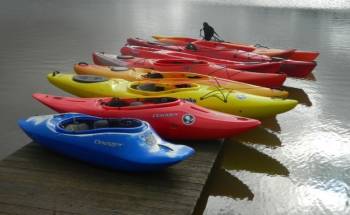 Cost is another major factor to consider. Kayaks can range anywhere between a few hundred dollars to a few thousand, so there needs to be a fair amount of thought put into the buying process. The cost depends on the brand, type, size, and material. What time of year you buy a kayak can also have a large impact on the cost. Offseason during the colder months is the best time of the year, price-wise, to buy a kayak. It may be harder to find exactly what you want during this time though, as many retailers are clearing out their current stock to make room for the new models. Buying used kayaks is also a good option for those on a budget, but it can sometimes be difficult to find exactly what you want.
Cost is another major factor to consider. Kayaks can range anywhere between a few hundred dollars to a few thousand, so there needs to be a fair amount of thought put into the buying process. The cost depends on the brand, type, size, and material. What time of year you buy a kayak can also have a large impact on the cost. Offseason during the colder months is the best time of the year, price-wise, to buy a kayak. It may be harder to find exactly what you want during this time though, as many retailers are clearing out their current stock to make room for the new models. Buying used kayaks is also a good option for those on a budget, but it can sometimes be difficult to find exactly what you want.
Color may not seem to be of the greatest importance to many paddlers, although some paddlers may be very particular about the color to fit their personal preference, and that is ok. However, the most important thing to remember with color selection is safety. If you are in trouble on the water, you want to be as visible as possible, and the brighter the color of the kayak, the more visible it will be. With this in mind, it may be smart to steer clear of any colors that might blend in.
These are many of the main factors to consider in buying a kayak. However there are additional features that should still be given consideration. The world of kayaking is immense and the possibilities for recreation and fun seem endless. Get out there and go explore the water!
It has been exactly a month since I started my internship with the PTRF, and today marks the first of my kayaking escapades on the Tar-Pamlico River Water Trail. I was privileged to be accompanied by Guy Blackwell and Andy Anderson, two PTRF volunteers very familiar with the Tar-Pamlico waterways. We all met at 9:30 in the morning at Mason’s Landing, (http://tinyurl.com/omnk5ow) a river access point near the mouth of Tranters Creek, one of the Tar River’s tributaries (The link above shows a map of the location of Mason’s Landing, but is called Clarks Neck Road Access). The sky was a little overcast and there was a slight chill in the air as we set out down the winding waterway of Tranters Creek towards the Tar River. Cypress trees lined the bank to the left, each one surrounded by dozens of cypress knees stretching their necks out of the water. A small sailboat rested at anchor to our right as we rounded a bend, bringing the Tar River into view ahead.
On our merging with the Tar River, we turned and began the four mile paddle upstream to the Cypress Hideaway camping platform. The river was placid, with a slight breeze blowing at our backs. The currents on this part of the Tar River are primarily wind driven, so this breeze would usually have altered the current to aid our upstream paddle. However, recent heavy rains upstream had increased the water level so that there was a slight downstream current. Despite this, we moved upstream with ease, meandering past the wooded swamps East Carolina is known for. Upturned trees dotted the shoreline, the intricate weavings of their exposed roots resembling works of art. The occasional motor boat passed by, leaving small wakes that gently rocked our kayaks in the water. The sky had cleared to a beautiful blue at this point, and we continued upriver with the suns warming rays at our backs.
At length, the Cypress Hideaway platform came into view to the right, on the far side of a wide stretch of the river. It was nestled behind a row of trees on the shore, its structured form contrasting with the trees and underbrush surrounding it. If it were summertime, the leaves on the trees would likely have hidden it from view. We traversed across the river and docked our kayaks in a tiny inlet, getting out to inspect the platform and stretch our legs for a few minutes. On resuming the water, we merged with the almost imperceptible downstream current and paddled along with it. We navigated under low hanging cypress branches stretching out over the water. Each branch was adorned with Spanish moss, resembling fingers reaching towards the water.
A small island appeared to the left. Two small makeshift docks reached out from its banks and a rope swing hung over the water. It is a favorite spot for boaters to spend a summer afternoon fishing and hanging out with friends. I paddled around the far side of the island and passed a fishing boat lazily drifting off the island’s shore. Every so often a fish could be seen leaping out of the water, and hawks drifted lightly on the breeze overhead. The sheer beauty and serenity of everything surrounding me was striking. The sun warmed me as I drifted downstream, and I could think of nothing better than staying on the water all afternoon. All too soon however, Mason’s Landing appeared in front of us. The kayaks were quickly loaded on their trailer, and the trip was over. But this was only the first of many trips, and something tells me that even greater ventures lie in wait for me in the future on the beautiful Tar-Pamlico River.
Clear sunny skies, with temperatures in the 40’s, and just enough wind chill to convince me it was still winter. I couldn’t ask for much better weather to go check out several of the camping platforms along the Tar-Pamlico River Water Trail for the first time. The first stop on the trip was to the Vollmer platform. It is located in what is called “the back 40” in the rear of Vollmer Farm, a beautiful 5th generation family farm in Bunn. The platform is situated on the edge of a large field, on a slight rise above the river with a small line of trees separating it from the water. As I stood on the deck, I could look down through the trees at the Tar River lazily flowing by. On leaving the platform, I followed a tree lined trail along the riverbank for about 50 yards upstream that ended with a short staircase on the right leading down to a small beach, offering easy river access for kayaks and canoes.
The Bourne platform was the next stop, located in the Dunbar vicinity near Tarboro. After driving down a long road with fields on my left and a single row of trees on my right, the platform came into view on the left. Positioned in the far rear of the Bourne family farm, it is surrounded on 3 sides by underbrush and trees, with the Tar River meandering by 10 yards behind it. It feels far separated from society, despite the fact that it is only minutes away. A 50 yard walk along the tree line brought me to a downward sloping trail that ends at the river, providing an easy entry and exit for boaters.
The last stop of the day was at the Panola platform, only a couple of miles from downtown Tarboro. In spite of its close vicinity to the town, it is tucked away in the woods behind the fields of Panola farm. The platform is found on the top of a steep bank overlooking the river. As I was gazing out on the river, I could see the wind blowing against the surface of the water, creating a ripple effect that caught the sun’s rays making the river shimmer. Looking down, I could see the river access on the right, just a few steps away from the platform. There are stairs leading down the bank that allow for boats to be tied off or carried up, offering the quickest access to the river of the three platforms.
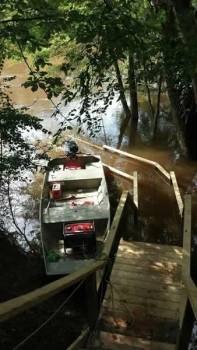 Another new camping platform has been constructed, this one with nice walkway and deck along the river to ease access. The platform is located on WRC gamelands, downstream of Tarboro in a beautiful site.
Another new camping platform has been constructed, this one with nice walkway and deck along the river to ease access. The platform is located on WRC gamelands, downstream of Tarboro in a beautiful site.
As you can see from our photos, the river is up and our walkway construction is getting an early test! Click a photo for a larger view.
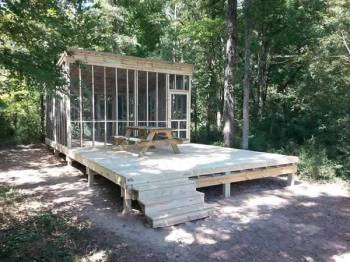 The new Bourne Platform site along the Tar River in Edgecombe County is now complete and ready for you to spend the night! Click on a photo to view a larger image.
The new Bourne Platform site along the Tar River in Edgecombe County is now complete and ready for you to spend the night! Click on a photo to view a larger image.
Check out the beautiful view from the platform.
To reserve this or any of our campsites, visit the Reservations page.
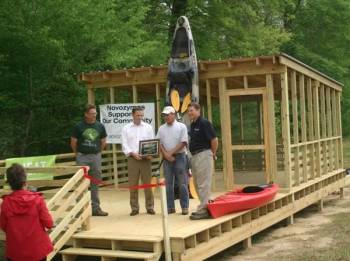 We're excited to have cut the ribbon on our newest camping platform, located near Vollmer Farms in Bunn and built with with $5,000 assistance from Novozymes, a Louisberg company. A ribbon cutting was held on April 28, 2014; click the photo to view a larger image, or visit the Facebook gallery to view all photos from the ribbon cutting.
We're excited to have cut the ribbon on our newest camping platform, located near Vollmer Farms in Bunn and built with with $5,000 assistance from Novozymes, a Louisberg company. A ribbon cutting was held on April 28, 2014; click the photo to view a larger image, or visit the Facebook gallery to view all photos from the ribbon cutting.
This is the fifth camping platform erected and the first in Franklin County. The other platforms are located in Rocky Mount, and Pitt and Edgecombe counties. The platforms are accessible only by river, and feature wooden platforms and screened-in rooms for camping; our plans are to build a total of 15 platforms, about 10 to 15 miles apart.
We're excited that kayakers and canoeists will now be able to extend their overnight trips with the addition of the new camping platform. Visit our Reservations page to make reservations for this or any of the other platforms, for a night or for an extended trip.
By accepting you will be accessing a service provided by a third-party external to https://tarpamlicowatertrail.org/
